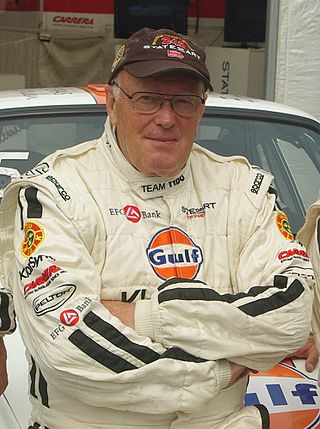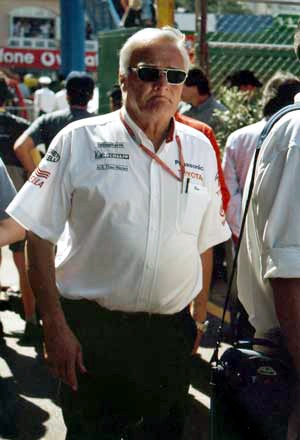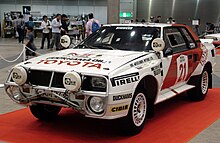
The Toyota Celica is an automobile produced by Toyota from 1970 until 2006. The Celica name derives from the Latin word coelica meaning heavenly or celestial. In Japan, the Celica was exclusive to Toyota Corolla Store dealer chain. Produced across seven generations, the Celica was powered by various four-cylinder engines, and body styles included convertibles, liftbacks, and notchback coupé.

Juha Matti Pellervo Kankkunen is a Finnish former rally driver. His factory team career in the World Rally Championship lasted from 1983 to 2002. He won 23 world rallies and four drivers' world championship titles, which were both once records in the series. Both Sébastien Loeb and Sébastien Ogier have since collected more world titles, but no driver was able to repeat Kankkunen's feat of becoming a world champion with three different manufacturers until Ogier matched this achievement in 2020.

Group B was a set of regulations for grand touring (GT) vehicles used in sports car racing and rallying introduced in 1982 by the Fédération Internationale de l'Automobile (FIA). Although permitted to enter a GT class of the World Sportscar Championship alongside the more popular racing prototypes of Group C, Group B are commonly associated with the international rallying scene during 1982 to 1986 in popular culture, when they were the highest class used across rallying, including the World Rally Championship, regional and national championships.

Markku Allan Alén is a Finnish former rally and race car driver. He drove for Fiat, Lancia, Subaru and Toyota in the World Rally Championship, and held the record for most stage wins (801) in the series, until Sébastien Loeb overtook it at the 2011 Rally Catalunya. Alén's phrase "now maximum attack" became well-known.

Stig Lennart Blomqvist is a retired Swedish rally driver. He made his international breakthrough in 1971. Driving an Audi Quattro for the Audi factory team, Blomqvist won the World Rally Championship drivers' title in 1984 and finished runner-up in 1985. He won his home event, the Swedish Rally, seven times.

Björn Waldegård was a Swedish rally driver, and the winner of the World Rally Championship for drivers in 1979. His Swedish nickname was "Walle".
Toyota Gazoo Racing Europe GmbH (TGR-E) is an automotive engineering and motorsport services facility based in Cologne, Germany. It is fully-owned and controlled by Toyota Motor Corporation.
Ian Duncan is one of Kenya's most successful rally drivers. He was Kenyan Rally Champion six times, and achieved outright victory in a World Rally Championship round when he won the 42nd Trustbank Safari Rally in 1994. This was one of seven consecutive top ten finishes in the event from 1990 to 1996, despite its notorious attrition rate.

Per Torsten Eklund is a Swedish Rally and Rallycross driver. His nickname is "Pekka". In rallying he never made it to the very top but he has been very successful in his later rallycross career.

Ove Andersson, nicknamed Påven, was a Swedish rally driver and the first head of Toyota's F1 programme.

Harry Källström, nicknamed "Sputnik", was a Swedish professional rally driver who debuted in 1957 and competed in the World Rally Championship in the 1970s. Prior to the forming of the WRC, Källström won the RAC Rally in a Lancia Fulvia 1.6 Coupé HF in 1969 and 1970. In 1969, he also captured the European Rally Championship title.
The 1986 World Rally Championship was the 14th season of the Fédération Internationale de l'Automobile (FIA) World Rally Championship (WRC). The season consisted of 13 rallies, including all twelve venues of the previous season as well as the addition of the Olympus Rally. This marked the return of the WRC to the United States and North America, as well as the first world rally to be held on the western side of the continent. The December rally would also be the only WRC event to feature Group B competition in the United States.

The Toyota Celica GT-Four is a high performance model of the Celica Liftback that was produced from 1986 to 1999, with a turbocharged 3S-GTE engine, and full-time AWD. It was created to compete in the World Rally Championship, whose regulations dictate that a manufacturer must build road-going versions of the vehicle in sufficient numbers. These vehicles are referred to as "homologation special vehicles".
The 1989 World Rally Championship was the 17th season of the Fédération Internationale de l'Automobile (FIA) World Rally Championship (WRC). The season consisted of 13 rallies, with some adjustments to the schedule versus the previous season. The WRC ended its participation in North America by removing the Olympus Rally from the schedule, implementing in its place Rally Australia. An anomaly in the schedule was that 1989 was the only year in which the Swedish Rally and the Rallye de Monte Carlo were switched in place, with the Swedish event taking place to start the year. This made it the second and last time that Monte Carlo would not mark the first event of the WRC season until the 2009 season.
Lars-Erik Torph was a Swedish rally driver. He debuted in the World Rally Championship in 1980 and took his first points at his home event, the Swedish Rally, in 1984. Driving a Toyota Celica TCT, a Toyota Supra 3.0i and an Audi Coupé Quattro, he went on to finish on the podium four times. After just turning 28, Torph and his co-driver Bertil-Rune Rehnfeldt died while spectating the 1989 Monte Carlo Rally, after Lancia driver Alex Fiorio lost control of his Delta Integrale and crashed into them.
Andrea Aghini Lombardi is an Italian rally driver. He won the 1992 Rallye Sanremo and took four other podium finishes in the World Rally Championship from 1992 to 1995. In 1992, he also won the Race of Champions, after beating Carlos Sainz in the semi-final and Colin McRae in the final.

The Lancia Delta HF is a Group A rally car built for the Martini Lancia by Lancia to compete in the World Rally Championship. It is based upon the Lancia Delta road car and replaced the Lancia Delta S4. The car was introduced for the 1987 World Rally Championship season and dominated the World Rally Championship, scoring 46 WRC victories overall and winning the constructors' championship a record six times in a row from 1987 to 1992, in addition to drivers' championship titles for Juha Kankkunen and Miki Biasion, making Lancia the most successful marque in the history of the WRC and the Delta the most successful car.

The Scuderia Lancia, which later became the Squadra Corse HF Lancia, is the racing workshop of the Lancia car company, created in 1952 by Gianni Lancia, son of the brand's founder. The Scuderia Lancia officially began competing in motor sports, particularly in rallying, where it distinguished itself in the Carrera Panamericana, the Targa Florio and the Mille Miglia. The team also entered Formula 1 in 1954–1955, without particularly shining. The Squadra Corse bounced back in the World Endurance Championship with three world titles between 1979 and 1981, and in rallying, winning eleven constructors' titles and four drivers' titles between 1974 and 1992. Since the end of 1991, Lancia has ceased all official involvement in motor racing.
The 1988 Race of Champions was the inaugural event and was held on December 4 at the Autodrome de Linas-Montlhéry near Paris, in memory of Henri Toivonen, who died while leading the 1986 Tour de Corse, and to celebrate the tenth anniversary of the world championship for rally drivers. This first event was the only Race of Champions event to feature a more conventional single-car rally stage format.













